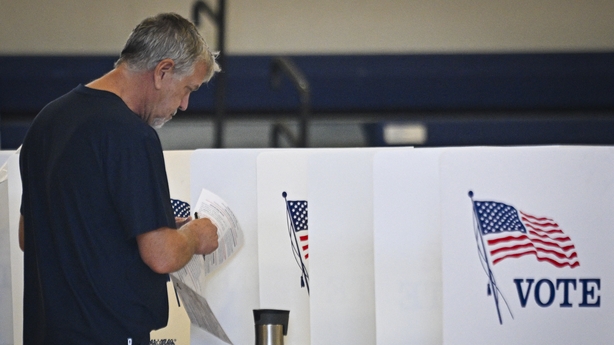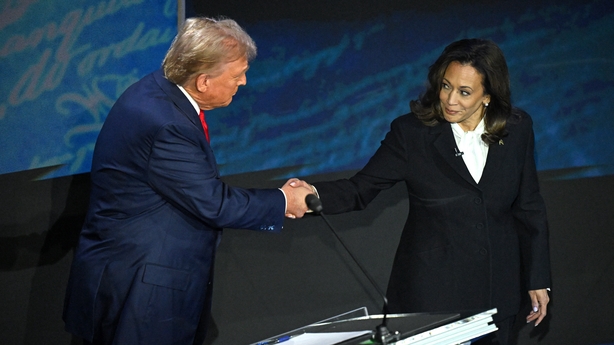The US presidential election will take place on 5 November, but the winner of the razor-thin race between Democrat Kamala Harris and Republican Donald Trump may not be known until days after the polls close.
As ballots are counted, one candidate may appear to be leading based on early returns, only for a rival to close the gap as more votes are tallied.
In 2020, some states experienced a "red mirage," in which Mr Trump was leading on election night, before a "blue shift" saw Democrat Joe Biden overtake him, a phenomenon Mr Trump used to amplify his false claims that the election was stolen.
Nothing untoward had occurred.
Democrats tend to live in more populous urban areas, where counting votes takes longer.
Democrats also have embraced postal voting more readily than Republicans after Mr Trump's false claims that postal ballots are untrustworthy, and those ballots take longer to count than election day votes.
Mr Trump has both encouraged and criticised early and post-in voting in 2024.
There are seven battleground states likely to decide the election, each with its own rules for handling and counting ballots.
Here's what to expect on election day and beyond:
Arizona
Voting by post is extremely popular in Arizona - nearly 90% of voters cast their ballots early, most by post, in 2020.
Election officials in Arizona can begin processing and tabulating postal ballots upon receipt, but results cannot be released until one hour after polls close.
Any postal ballots dropped off on election day itself cannot be processed until the polls have closed.
That is often a sizable number.
In 2022, those "late early" votes comprised one-fifth of all ballots in Maricopa County, the state's largest – and can take days to count.
The initial results on election night should be mostly early votes, which could favour Ms Harris, before the numbers shift toward Mr Trump as election day votes are tallied.
They could move back toward Ms Harris in the days to follow as late-arriving postal ballots are tabulated.

Georgia
Early in-person voting is popular in Georgia, where officials expect 65% to 70% of ballots to be cast at early poll locations.
Absentee or postal ballots, which may comprise around 5% of the vote, can be processed two weeks before the election.
This includes steps like verifying signatures.
However, workers must wait until election day to begin counting them.
All early votes cast in person and by post must be counted and reported by 8pm Eastern Time (midnight Irish time) on election night, according to state law.
Officials are aiming to have all votes, including those from election day, tallied by midnight Eastern Time.
Ballots from overseas and military voters will be accepted up to three days after the election if postmarked by 5 November.
There were more than 21,000 such ballots requested, so an extremely close election might not be resolved until those votes are tabulated.
Michigan
Since the 2020 election, Michigan has instituted early in-person voting for the first time and begun permitting jurisdictions with more than 5,000 people to begin processing and tabulating postal ballots eight days before election day.
Smaller jurisdictions can do so the day before 5 November.
Officials hope those changes will allow the state to report results more quickly than in 2020, when postal ballots could not be processed in advance.
That created a "red mirage" on election night, when the state's early counts of election day votes favoured Mr Trump.
Mr Biden eventually surpassed Mr Trump on the strength of postal ballots, which took longer to tally.
Mr Trump falsely claimed he was the victim of fraud.

Nevada
Nevada's slow vote counting in 2020 was the subject of countless memes.
News outlets did not call the state for Mr Biden until five days after election day, but officials say changes since then should speed up the process.
Most notably, counties were permitted to begin processing and counting postal ballots on 21 October.
In addition, workers can start tabulating early in person votes at 8am Pacific Time (3pm Irish time) on election day, rather than waiting until polls close.
But Nevada still might not get called right away.
Postal voting has grown popular in the state, and it is the only battleground that accepts late arriving postal ballots.
Any ballot postmarked by 5 November will still be counted if it arrives within four days.
Those late ballots historically favour Democrats, so a shift towards Ms Harris could occur as votes are counted after election day.
North Carolina
Election officials start processing and scanning postal ballots ahead of election day.
After polls close, the first reported results will likely be mostly postal ballots as well as early in person votes.
Election day votes will be counted and reported throughout the evening, with full results expected by midnight.
Ms Harris may appear to lead early thanks to postal ballots, while Mr Trump could close the gap as election day votes are counted.
If the election is as close as polls suggest, the outcome in North Carolina may remain unclear for a week or more.
Absentee ballots that arrive on 5 November, as well as ballots from overseas and military voters, are tallied during the ten-day canvass period that follows election day.
In 2020, media outlets did not call North Carolina for Mr Trump until 13 November, ten days after the election.

Pennsylvania
Perhaps the most important battleground, Pennsylvania did not have a clear winner in 2020 for four days after election day, as officials sifted through a huge backlog of postal ballots.
The state is among only a handful that do not permit election workers to process or tabulate postal ballots until 7am Eastern Time (11am Irish time) on election day.
This means it will likely again take days before the outcome is known.
With more Democrats than Republicans voting by post, the early results - based on in person election day votes - will probably show Mr Trump ahead, but his lead will likely shrink as more postal ballots are counted.
That pattern in 2020 prompted Mr Trump to falsely claim fraud.
This year, a new law requires most counties to announce at midnight on election night how many postal ballots remain to be counted in an effort to forestall conspiracy theories.

Wisconsin
Like Pennsylvania, Wisconsin is among the few states that do not allow election officials to process or count postal ballots until the morning of the election.
This means there can be a delay in reporting the results of those early votes.
In addition, many of the state's largest cities transport postal ballots to a centralised location for processing and tabulating.
That can lead to significant batches of votes getting reported all at once in the early morning after polls close.
In 2020, Mr Trump and his allies falsely claimed fraud after Milwaukee, the state's largest city, reported nearly 170,000 absentee ballots.
This gave Mr Biden a huge spike that moved him into the lead for the first time.
But that increase was expected due to the way the city processes those ballots and the fact that Democrats were more likely to vote by post.
A similar pattern is probable in 2024
Read more:
Harris, Trump in dead heat across swing states - poll
Latest US election stories

